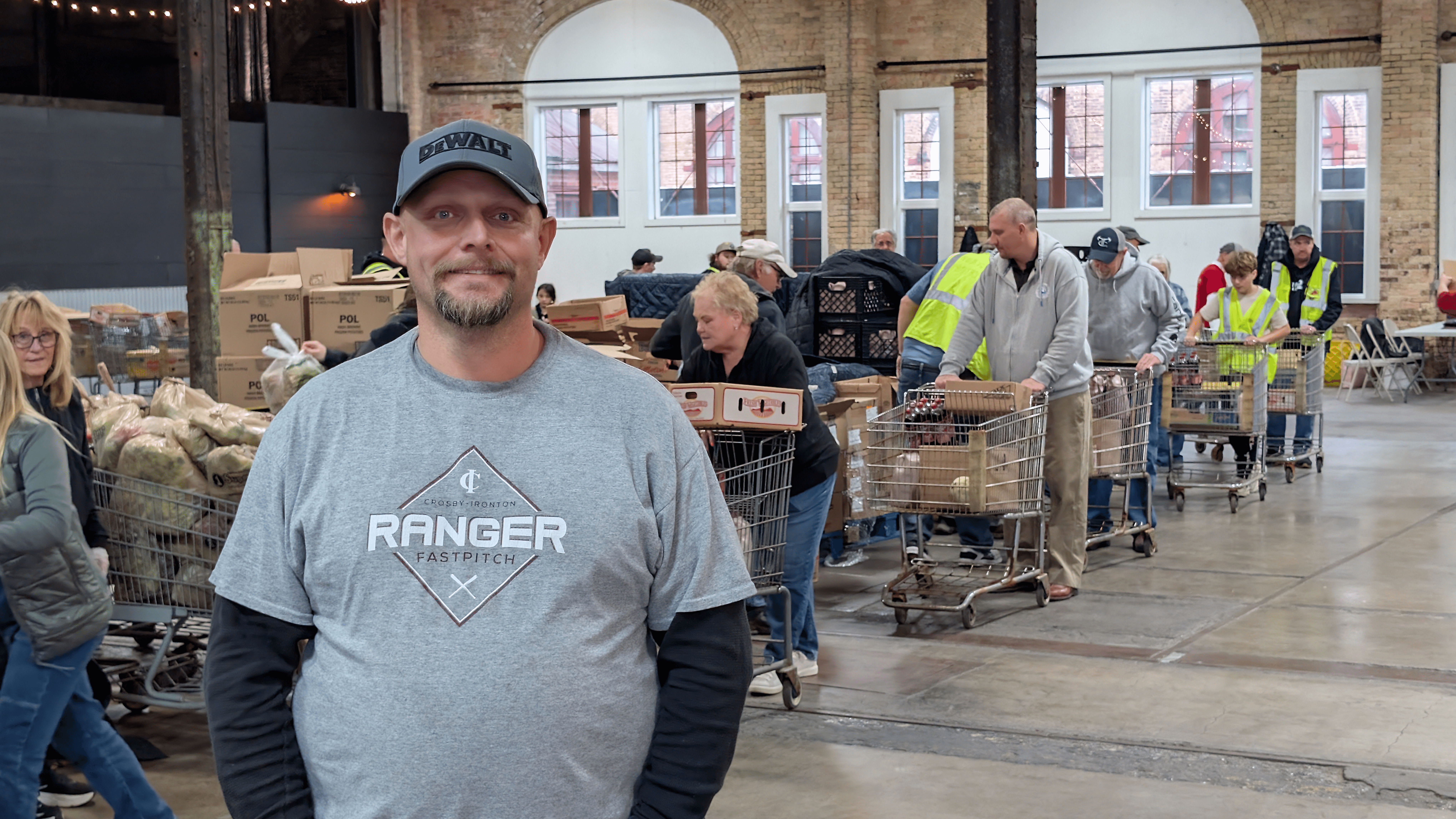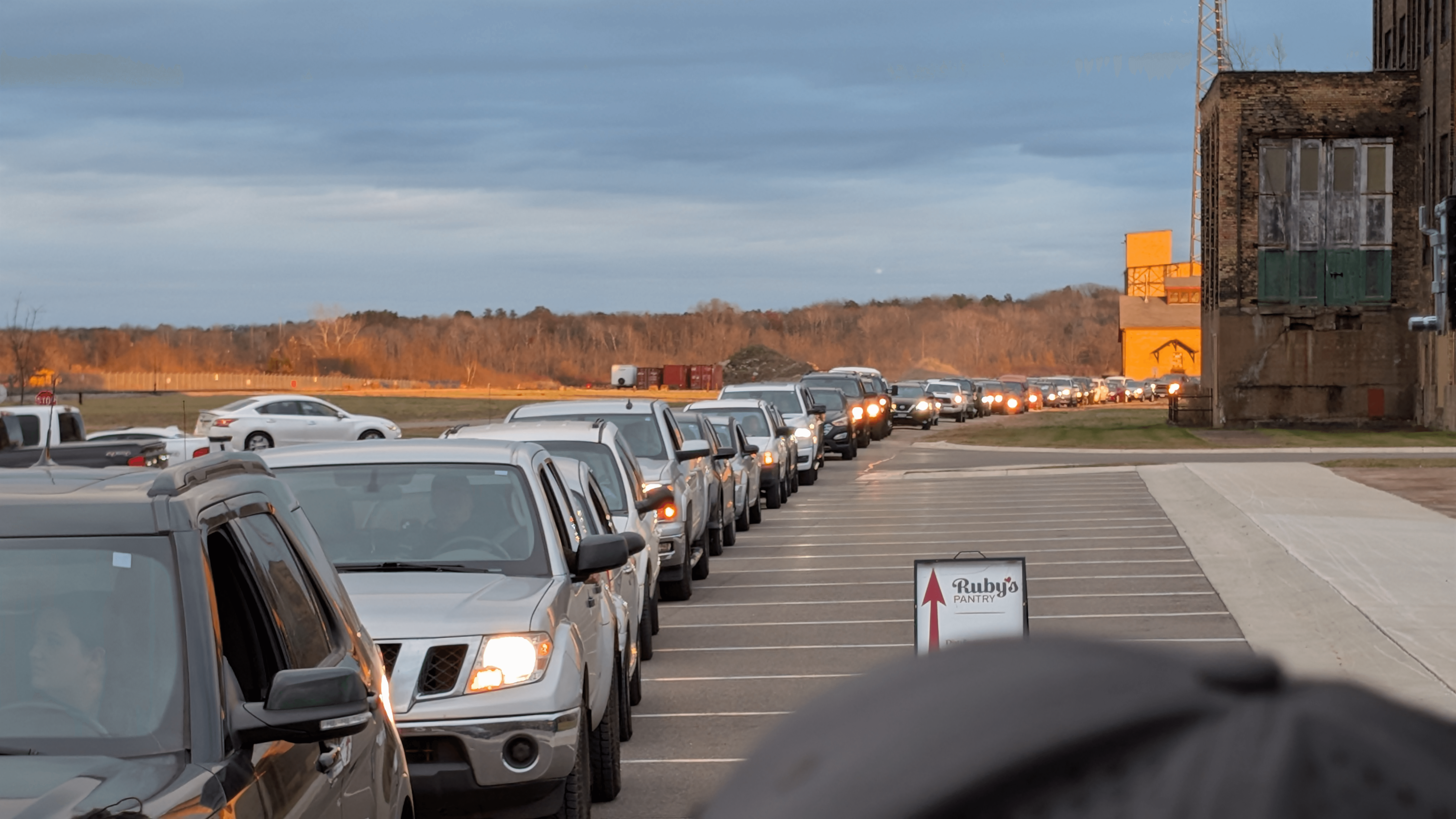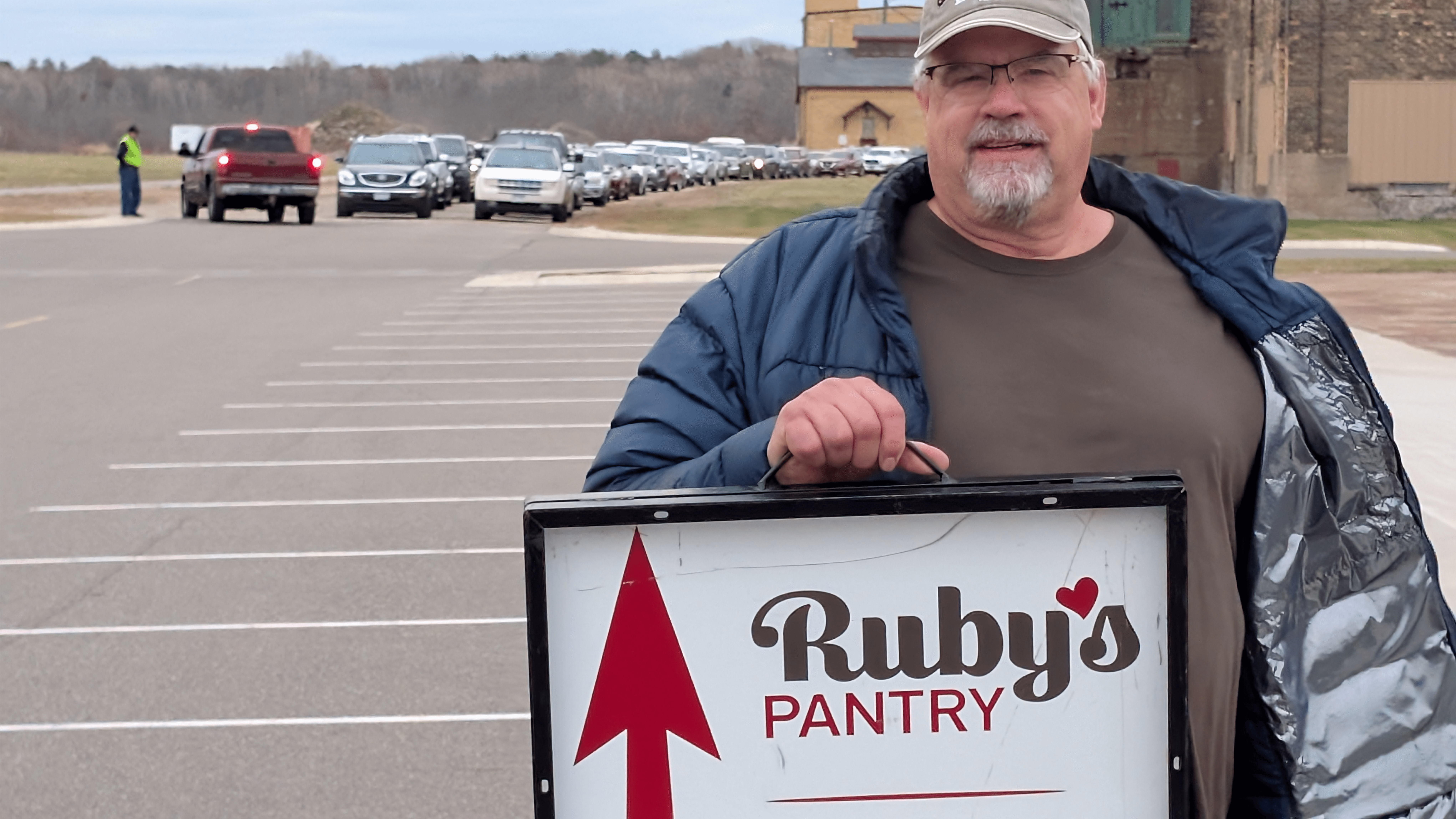Brainerd's Game-Changing Food Giveaway: How Ruby's Pantry is Revolutionizing Generosity
Lakes Area Buzz
Archives
Brainerd's Game-Changing Food Giveaway: How Ruby's Pantry is Revolutionizing Generosity
SIGN UP FOR OUR NEWSLETTER
No Questions, Just Groceries: Brainerd’s Shockingly Generous Food Giveaway |
Anyone can come—no paperwork, no restrictions—just a $25 cash donation for a trunkload of essentials. |
Picture a Tuesday afternoon at Brainerd’s Northern Pacific Center. Volunteers begin arriving hours before the doors open, gathering in anticipation of the semi-truck carrying thousands of pounds of food.
By 4:30 p.m., a steady line of cars moves through the historic building's drive-through lanes. By dusk, roughly 228 households will leave with fresh groceries—no paperwork, no income checks, no judgment.
This is Ruby’s Pantry Brainerd, a monthly food distribution that has quietly become a lifeline in Crow Wing County, where more than 5,000 residents face food insecurity.
What makes this operation remarkable isn’t just the scale—it’s the spirit behind it. From Teen Challenge participants rebuilding their lives to seasoned church volunteers and everyday neighbors, Ruby’s Pantry runs on a simple belief: everyone deserves good food, and serving others strengthens the entire community. |
How Ruby's Pantry Works |
Ruby’s Pantry operates on a simple, neighbor-first model: for a $25 cash donation, anyone—regardless of income—receives a “share” of food that typically includes produce, protein, bread, dairy, and shelf-stable items.
“Anybody can come, no matter how much money you make,” explains site coordinator Curtis Hiltbrunner, who has led the Brainerd distribution alongside Tim Lake since the operation moved from Journey North Church to Risen Church. “You can roll in an Escalade, or you can push yourself in on a pedal bike if you want,” Curtis says.
Where does the $25 go?
Ruby’s Pantry receives no government funding and operates as a 501(c)(3) nonprofit entirely sustained by donations and partnerships with more than 170 food manufacturers and distributors. The result is a system that’s accessible, judgment-free, and built entirely around the idea that if you eat, you qualify. |
A Choreographed Community Effort |
Moving thousands of pounds of food from a semi-truck to a car trunk isn’t just work—it’s a well-rehearsed neighborhood operation.
Tim, Curtis and others arrive at the Northern Pacific Center around 1 p.m. on distribution day to start preparing the space. The delivery truck rolls in around 2:30 p.m., and volunteers jump into action, unloading pallets and sorting items. “We have to sort through all the food. We have to make sure that all of it is fresh. Open up boxes and get it set up on our line here,” Curtis says.
Mitch Brinks, a volunteer who helps organize both the food and the workers, describes the rhythm: “We get a full truck that comes in, and my job is to organize the volunteers to sort out the food, count it all, and then we line it up in order from heaviest items to the lighter items so we don't have any of the products getting damaged.
We ask the volunteers to respect the grocery items as if it was their own.” Each item is assigned a number on the floor—usually one per share, though some items like chips are doubled. Volunteers fill carts based on these numbers, creating a smooth, steady flow.
By 4:30 p.m., distribution begins. Six cars are brought inside at a time, and volunteers load trunks with practiced efficiency. By 5:30 or 5:45 p.m., the final vehicles roll out.Afterward, the team sweeps, clean, and resets the space, often wrapping up around 7 p.m—until it all starts again next month. |
What's in a Share? |
The contents of a Ruby’s Pantry share change month to month, depending on what corporate donors provide, but certain staples show up regularly. “We typically get a protein—there’s chicken today,” Mitch explains during a recent distribution. “Potatoes every time.
This time we got a lot of milk, chocolate milk. Eggs—we got liquid eggs and regular eggs. Usually a bunch of chips, taco shells, packets of rice, a lot of produce.”
On this particular Tuesday, the haul included a wide mix of fresh items—peppers, tomatoes, lettuce, asparagus, onions—and plenty of bakery goods: three to four loaves of bread per share, or a combination of loaves and buns. Pop and produce are also among the most common items volunteers bag up for guests.
One misconception Mitch and Curtis hear often involves the dates on the packaging. “Yes, some of the food is past the sell-by date. It doesn't mean it’s bad. It's just how we get it,” Curtis says. Ruby’s Pantry partners with more than 170 manufacturers and distributors who donate surplus, overproduced, or near-date items—food that’s still perfectly safe but can’t remain on store shelves. |
The Volunteer Backbone |
If food is the lifeblood of Ruby’s Pantry, volunteers are its heartbeat. Teen Challenge, the addiction recovery program run by Minnesota Adult & Teen Challenge, sends around 15 participants each month to help with the heavy lifting. “If we didn’t have Teen Challenge, we would be sunk,” Curtis says.
Curtis, a long-time volunteer, captures the spirit of the operation with a simple observation: “How many different generations do you see here?” he asks, scanning the busy scene. “All of them,” he answers with a smile.
What keeps him returning month after month is watching “people of all ages here from infants to seniors… they all come together for one purpose, to serve others.” For Curtis, that intergenerational camaraderie is at the heart of Ruby’s Pantry—service as a shared family tradition, passed down and lived out in real time.
For Trent Jensen, a Teen Challenge supervisor in the kitchen who has been volunteering since 2023, the work carries personal meaning. “I did a lot of dirt in the community,” he says. “Giving back to the community is one of the best ways that I can show the community that I’ve changed or that people can change.”
Pastor Jason Erickson of Risen Church, the hosting congregation, sees the distribution as an extension of his mission to be present beyond Sunday mornings. “My goal is to be a visible, active presence in the community—a voice reaching beyond the church walls, not just someone known for an hour and a half on Sunday morning.” he says. When Curtis and co-organizer Tim Lake approached him about hosting Ruby’s Pantry, Jason didn’t hesitate: “We said yeah, let’s pick that up.”
The sense of unity among volunteers is unmistakable. “Everybody who comes has the attitude of, ‘Hey, let’s just serve our community,’” Erickson says. “We have Teen Challenge. We have volunteers from different churches. Some don’t even go to church. But we all come together the second Tuesday of every month—and we’re like family.” |
A Space Donated, A Mission Sustained |
Ruby’s Pantry Brainerd operates inside one of the most historic spaces in the region—the Northern Pacific Center. With soaring ceilings, wide lanes, and a layout built to move railcars more than a century ago, it has become the perfect home for a modern drive-through food distribution.
But the location isn’t just convenient—it’s a blessing. Mike Higgins, the owner of the Northern Pacific Center, donates the space at no cost, allowing every dollar raised to go directly toward food and community support rather than overhead.
“We’re blessed to be able to do this at the Northern Pacific Center,” Curtis reflects. The layout allows volunteers to bring six cars in at a time, load trunks comfortably out of the weather, and keep traffic moving quickly—something that simply wouldn’t be possible in most buildings. For families showing up in the middle of a snowstorm, or for seniors who appreciate not having to stand in line, the indoor setup isn’t just nice—it’s essential.
The location also carries a certain weight. Serving neighbors inside a landmark built in 1871—once a hub for trains that fueled the region’s growth—feels like a continuation of its original purpose: connecting people, moving essential goods, and strengthening the communities along its tracks. Today, instead of rail workers, it’s volunteers with carts and clipboards. Instead of freight, it’s groceries and produce. But the heart behind the work hasn’t changed.
What the Northern Pacific Center provides is more than shelter. It gives Ruby’s Pantry the capacity to grow, adapt, and serve at a scale that matches the region’s needs—especially as Curtis and the team work to rebuild toward their pre-pandemic goal of 450 monthly shares.
Without this donated space, the operation would be smaller, slower, and far more vulnerable to Minnesota’s unpredictable weather. With it, Ruby’s Pantry continues to operate like clockwork, month after month, providing a steady, reliable lifeline for families across Crow Wing County. |
Goals and Growth |
Ruby’s Pantry, Brainerd currently distributes about 275 shares each month—a noticeable drop from pre-pandemic years, when the site regularly served around 400. “I would like to see us doing around 400 shares a month again, like we used to. ” Curtis says. COVID-19 slowed participation, and the site has been steadily working to rebuild both awareness and turnout. They will be bringing in 300 shares next month.
Reaching that goal will require one thing above all: people showing up. Volunteers are primarily recruited through announcements at Risen Church, but the operation welcomes anyone willing to lend a hand.
“Come on in. We’ll treat you with love, kindness, and respect. Then we’ll show you what the ropes are. And we’d love to have you,” Trent says. Whether unloading food at 2 p.m. or loading trunks later in the afternoon, every set of hands makes a difference. |
How to Get Involved |
For anyone interested in receiving food, Ruby’s Pantry Brainerd distributes on the second Tuesday of every month at the Northern Pacific Center, located at 1511 Northern Pacific Road.
Guests should arrive between 4:30 and 6:00 p.m., though cars often begin lining up as early as 1 p.m. Each share requires a $25 cash donation—no income requirements, no residency restrictions, and no need to prove need. If you eat, you qualify.
Volunteers are always welcome and can get involved in a few simple ways: by reaching out to Risen Church at info@risenchurch.life, by filling out a volunteer application through Ruby’s Pantry’s website, https://www.rubyspantry.org/become-volunteer or by simply showing up early on distribution day to speak with coordinators.
Those willing to help unload the truck should arrive around 2 p.m., while anyone interested in assisting with sorting, distribution, or loading cars should come around 3:00 p.m. Every role matters, and new volunteers are guided through the process with plenty of support. |
Why It Matters |
Food insecurity affects 7.9% of Crow Wing County residents—about 5,180 people. In a region where winter arrives early and stretches long, access to affordable, fresh food can be the difference between a family thriving or simply getting by. Ruby’s Pantry doesn’t just fill stomachs; it restores dignity and builds community.
“It’s fun to rub shoulders with people in the community, and it’s just an opportunity for us to kind of be a smiling face,” Pastor Jason Erickson says. “Especially when there’s a lot of people in need around this time of the year, it’s fun to just try to make somebody’s day a little bit brighter.”
That impact extends beyond food. The 10% of donations that stay local support programs like Operation Sandwich, which provides meal kits to kids when school isn’t in session, Timber Bay, who works with "At Risk" Kids in the community and Lighthouse Beginnings, who work with the homeless in the area.
By redistributing funds within the community, Ruby’s Pantry creates a ripple effect that reaches far beyond the Northern Pacific Center’s walls, strengthening families, supporting children, and keeping neighbors connected when it matters most. |
A Model That Works |
If funding, space, and volunteers were unlimited, Curtis says he wouldn’t change a thing. “It’s pretty dialed in. We’ve got it down to a T. It works out really well here,” he says. The strength of Ruby’s Pantry lies in its simplicity: donated food, donated space, and donated labor coming together in a streamlined system that meets a real need.
What Ruby’s Pantry Brainerd shows is that addressing food insecurity doesn’t require massive infrastructure or government programs—it requires people willing to show up, corporations willing to share their surplus, and a community that believes everyone deserves access to good food.
As the holiday season approaches and temperatures drop, the need will only grow. Whether you’re a retiree in Baxter looking for a way to give back, a parent in Nisswa stretching a grocery budget, or a local business owner wanting to support your neighbors, there’s a place for you on the second Tuesday of the month.
Curtis puts it simply: “We are all volunteers. None of us make a penny doing this.” The reward isn’t financial—it’s the satisfaction of knowing that in middle Minnesota, neighbors still take care of neighbors, one trunk-load of groceries at a time.
Have thoughts on Ruby's Pantry or ideas for future stories? Email us at joshua@lakesareabuzz.com. |




